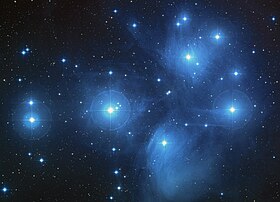Taygeta
| Observation data Epoch J2000.0 Equinox J2000.0 | |
|---|---|
| Constellation | Taurus |
| Right ascension | 03h 45m 12.49578s[1] |
| Declination | 24° 28′ 02.2097″[1] |
| Apparent magnitude (V) | 4.30[2] |
| Characteristics | |
| Spectral type | B6IV + ?[3] |
| U−B color index | -0.48[4] |
| B−V color index | -0.12[4] |
| Astrometry | |
| Radial velocity (Rv) | 10.1[2] km/s |
| Proper motion (μ) | RA: 21.24 ± 0.38[1] mas/yr Dec.: -40.56 ± 0.35[1] mas/yr |
| Parallax (π) | 7.97 ± 0.33 mas[1] |
| Distance | 440 ly (135 pc) |
| Details | |
| Taygeta | |
| Mass | 4.5[5] M☉ |
| Luminosity | 600[5] L☉ |
| 19 Tauri Ab | |
| Mass | 3.2[5] M☉ |
| Luminosity | 150[5] L☉ |
| Other designations | |
| Database references | |
| SIMBAD | data |
Taygeta is a double star in the constellation of Taurus and a member of the Pleiades open star cluster (M45).
It consists of a binary pair designated 19 Tauri A together with a single star visual companion, 19 Tauri B. 'A's' two components are themselves designated 19 Tauri Aa (officially named Taygeta /teɪˈɪdʒətə/,[6] the traditional name for the entire system)[7] and Ab.
Based on parallax measurements obtained during the Hipparcos mission, 19 Tauri A is approximately 440 light-years from the Sun.
Nomenclature
[edit]19 Tauri is the system's Flamsteed designation. It also bears the little-used Bayer designation q Tauri. The designations of the two constituents as 19 Tauri A and B, and those of A's components - 19 Tauri Aa and Ab - derive from the convention used by the Washington Multiplicity Catalog (WMC) for multiple star systems, and adopted by the International Astronomical Union (IAU).[8]
The system bore the traditional name Taygeta (or Taygete).[9] Taygete was one of the Pleiades sisters in Greek mythology. In 2016, the IAU organized a Working Group on Star Names (WGSN)[10] to catalogue and standardize proper names for stars. The WGSN approved the name Taygeta for the component 19 Tauri Aa on 21 August 2016 and it is now so included in the List of IAU-approved Star Names.[7]
Properties
[edit]Taygeta presents as a blue-white B-type subgiant with an apparent magnitude of +4.30. It is a spectroscopic binary, whose component stars have magnitudes of +4.6 and +6.1. They are separated by 0.012 arcseconds and complete one orbit every 1313 days.
The 8th magnitude visual companion, 19 Tauri B, is 69 arcseconds away. It is thought to be a yellow star somewhat more massive and larger than the Sun, and further away than the Pleiades cluster.[11]
Taygeta was once reported to be variable,[12] but has since been measured to be one of the least variable of stars.[13][14]
References
[edit]- ^ a b c d e van Leeuwen, F. (2007). "Validation of the new Hipparcos reduction". Astronomy and Astrophysics. 474 (2): 653–664. arXiv:0708.1752. Bibcode:2007A&A...474..653V. doi:10.1051/0004-6361:20078357. S2CID 18759600. Vizier catalog entry
- ^ a b "* q Tau". SIMBAD. Centre de données astronomiques de Strasbourg. Retrieved 2014-08-18.
- ^ Eggleton, P. P.; Tokovinin, A. A. (September 2008), "A catalogue of multiplicity among bright stellar systems", Monthly Notices of the Royal Astronomical Society, 389 (2): 869–879, arXiv:0806.2878, Bibcode:2008MNRAS.389..869E, doi:10.1111/j.1365-2966.2008.13596.x, S2CID 14878976.
- ^ a b Penston M.J. (1973). "Photoelectric UBV observations made on the Palomar 20-inch telescope". Mon. Not. R. Astron. Soc. 164 (2): 133–154. Bibcode:1973MNRAS.164..133P. doi:10.1093/mnras/164.2.133.
- ^ a b c d Professor James B. (Jim) Kaler. "TAYGETA (19 Tauri)". University of Illinois. Retrieved 2014-08-18.
- ^ Davis, George A. (1944). "The pronunciations, derivations, and meanings of a selected list of star names". Popular Astronomy. 52: 8–30. Bibcode:1944PA.....52....8D.
- ^ a b "Naming Stars". IAU.org. Retrieved 5 March 2018.
- ^ Hessman, F. V.; Dhillon, V. S.; Winget, D. E.; Schreiber, M. R.; Horne, K.; Marsh, T. R.; Guenther, E.; Schwope, A.; Heber, U. (2010). "On the naming convention used for multiple star systems and extrasolar planets". arXiv:1012.0707 [astro-ph.SR].
- ^ Allen, Richard Hinckley (1899). Star-names and their meanings. G. E. Stechert. p. 407. Retrieved 2009-10-10.
- ^ IAU Working Group on Star Names (WGSN), International Astronomical Union, retrieved 22 May 2016.
- ^ Huber, Daniel; Bryson, Stephen T; Haas, Michael R; Barclay, Thomas; Barentsen, Geert; Howell, Steve B; Sharma, Sanjib; Stello, Dennis; Thompson, Susan E (2016). "The K2 Ecliptic Plane Input Catalog (EPIC) and Stellar Classifications of 138,600 Targets in Campaigns 1-8". The Astrophysical Journal Supplement Series. 224 (1): 2. arXiv:1512.02643. Bibcode:2016ApJS..224....2H. doi:10.3847/0067-0049/224/1/2. S2CID 118621218.
- ^ Samus, N. N.; Durlevich, O. V.; et al. (2009). "VizieR Online Data Catalog: General Catalogue of Variable Stars (Samus+ 2007-2013)". VizieR On-line Data Catalog: B/GCVS. Originally Published in: 2009yCat....102025S. 1. Bibcode:2009yCat....102025S.
- ^ Percy, John R.; Wilson, Joseph B. (2000). "Another Search for Maia Variable Stars". The Publications of the Astronomical Society of the Pacific. 112 (772): 846. Bibcode:2000PASP..112..846P. doi:10.1086/316577.
- ^ Adelman, S. J. (2001). "Research Note Hipparcos photometry: The least variable stars". Astronomy and Astrophysics. 367: 297–298. Bibcode:2001A&A...367..297A. doi:10.1051/0004-6361:20000567.

